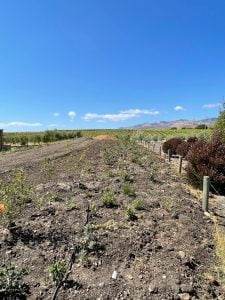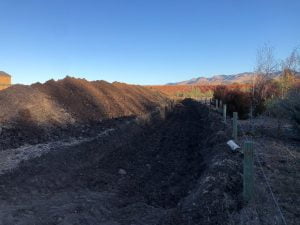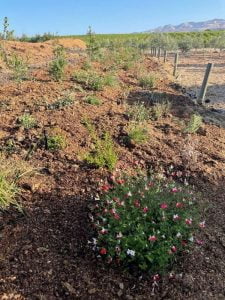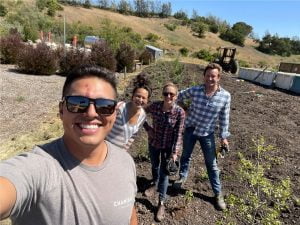Chamisal Vineyards – Installation of Miyawaki Mini-Forest to Increase Biodiversity of Vineyard Farmland and Build a Carbon Sink
Company Summary:
Chamisal made history in 1973 as the first winery in Edna Valley American Viticultural Area to plant grapevines. Our unique soil types and proximity to the ocean have focused our plantings on Chardonnay and Pinot Noir. Chamisal Vineyards has been SIP (Sustainability in Practice) certified in the vineyards since 2010 and was the second-ever winery to be SIP-certified in 2016. Sustainable practices at Chamisal Vineyards include the use of compost, cover crops, minimal organic fertilizers, a rooftop solar array, the introduction of drought-tolerant rootstock, the use of light weight glass and moisture-sensors to mitigate irrigation needs. We have an extensive water-recapture system that reclaims 100 percent of winery process water for irrigation needs.
Executive Summary:
Using techniques pioneered by the famed Japanese botanist Akira Miyawaki, we have established a mini-forest. 400 plants were planted after soil preparation with the objective of providing habitat for the local fauna and understand the potential of mini-forests to become carbon sinks. The project has been a fantastic team activity around a tangible sustainable goal and may lead into a different way to use our land.
Location of the Miyawaki forest before planting in the fall

Location of the Miyawaki forest after planting the following spring
Sustainable Target:
1) Increase the flora and fauna biodiversity on our vineyard land
2) Restore native habitat for plants, animals and insects
3) Explore the carbon sequestration potential of mini-forests
Partners:
None but with gratitude to local nurseries for local sourcing: Native Sons Nursery, Las Pilitas Nursery and West Covina Nursery.
Project Description:
About mini-forests and Akira Miyawaki
Akira Miyawaki is an important Japanese botanist known for his work on restoring natural vegetation on degraded land. He has developed a plantation technique to accelerate the growth of plants to increase forest output. His work is used across the globe and has expanded beyond its original application for the pulpwood industry. Miyawaki forests have received much attention lately as a way to restore rapidly natural habitats in dense metropolitan areas. The main principles of Mr Miyawaki are:
a) Identify 50 to 100 native species near the concerned land
b) Prepare the soil with a focus on organic matter and water retention
c) Interplant randomly the selected native vegetation with a high density and with the objective of creating vegetation layers (ground, 6 feet, 25 feet, 40 feet of final heights)
d) Weed and water the first 3 years and move toward no management in year 4
Miyawaki forest at Chamisal vineyard
The goal of our project was to utilize a non-productive portion of our property and turn it into a native habitat and a carbon sequestering native landscape utilizing the principles of Mr. Miyawaki. This project is going to aid in our company wide goal of becoming carbon neutral and increase the biodiversity on our farm. We hope that this native landscape will thrive for the next 30+ years.

Ground preparation with excavation before soil amendment addition
Execution of the project
We have selected a 1300 square meter of fallow ground next to our winery to plant the mini-forest. According to Mr. Miyawaki’s protocols, the soil was excavated 1 meter deep, and amended with layers of reused wood mulch from a local mushroom farm and composted grape waste. Over 400 plants were planted, utilizing over 30 native species in an assemblage designed to closely mimic a local, native oak woodland. The combination of amended soil and high density of planting should promote very rapid growth for this mini-forest, at 5 to 10 times the growth speed of a naturally occurring forest.
Unexpected surprises
The toughest part of the project was tracking down all the different species of native plant materials. After selecting the site and establishing the planting map, things went surprisingly fast. With some proper planning and a bit of teamwork this project actually was surprisingly easy.
Lessons Learned:
The project has resulted in a rise in awareness of biodiversity within our team. It was a great team binding activity around a sustainable goal. We believe that this project will lead to important learnings about our landuse..

Close up of the native plants in the mini-forest
Next Steps:
1) Fully establish the forest through the summer with supplemental irrigation and cover the area around the plants with mulch groundcover to prevent the growth of unwanted weeds.
2) Validate the growth rate of the forest and compute the carbon sequestration it will provide.
3) Validate the installation of the local fauna species in the mini-forest
4) Explore the possibility to augment forest growth by piping fermentation CO2 in the forest
5) If all works as expected, expand the number of mini-forest on the property and dot our farm with them
Potential For Replication:
The potential for replication is high. A small tractor is useful depending on size of project. Good teamwork and planning are necessary for proper implementation.

The Chamisal team after planting day from left to right: Christian, Andrea, Brianne and Fintan


